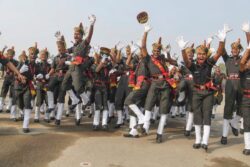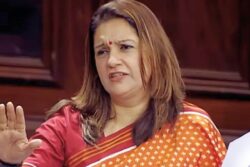Umesh Yadav: Rising from the cricketing backwaters of Vidarbha

Nagpur: A friend persuaded Umesh Yadav, 20, with no college degree or job then, to try leather-ball cricket. Yadav had nothing to lose.
 A year later he was playing in the Ranji Trophy. Less than three months after that, he had dismissed Rahul Dravid and VVS Laxman in the Duleep Trophy. At 22 he was playing for India. At 23 he had been bought for $750,000 in the 2011 IPL auction. At 24, after a promising tour of Australia, he was being hailed as India’s answer to the fast bowlers who had terrorised the country’s batsmen for decades. It is a fairytale, not quite in the league of Iqbal, but unlike the movie, it is real, and worth a trip to Nagpur in the May heat.
A year later he was playing in the Ranji Trophy. Less than three months after that, he had dismissed Rahul Dravid and VVS Laxman in the Duleep Trophy. At 22 he was playing for India. At 23 he had been bought for $750,000 in the 2011 IPL auction. At 24, after a promising tour of Australia, he was being hailed as India’s answer to the fast bowlers who had terrorised the country’s batsmen for decades. It is a fairytale, not quite in the league of Iqbal, but unlike the movie, it is real, and worth a trip to Nagpur in the May heat.
The hot wind of the dreaded Vidarbha summer stings as I get off the plane at Nagpur airport. It is 36° Celsius. At 8.15 am. I scurry for the airport bus. Even the thought of bowling fast appears suicidal. I head for Khaparkheda, a small town about an hour from Nagpur, where Yadav has built a two-storeyed house in which he lives with his father, two older brothers and their wives and children.
Nagpur, the geographical centre of India, is steeped in history. It also appears stuck in the past – a great city that has not quite cashed in on the liberalisation of the country’s economy. Nagpur is the largest city of the underdeveloped Vidarbha region of Maharashtra. There has been a long-standing demand for separate statehood for Vidarbha. Neglect is widespread; farmer suicides are common.
Vidarbha is a cricketing backwater as well. The team plays in the Plate League in the Ranji Trophy, where players usually toil in near-anonymity. Pritam Gandhe, Yadav’s captain on Vidarbha debut, never got an India chance despite his 340 first-class wickets. Yadav is the first Test cricketer the team has produced.
When I get to his house, I find him in the courtyard, wearing a Delhi Daredevils practice jersey; his father wears an India one. In the sitting room are two photographs of Yadav’s mother on the wall, including one with Yadav. She died over a year ago of a heart ailment.
“She used to ask only whether I had had proper food and rest, and whether I was fine,” Yadav says. “Never asked how I had bowled, how many wickets I had taken.” Cricket wasn’t exactly a priority for the family. Yadav’s father used to work in a coal mine; his oldest son moved to Goa to work in a shipyard after his wedding.
Life was tough. Yadav grew up in the small dwelling allotted to his father in Valli, a mine-workers’ settlement of 5000-odd people, about five kilometres from Khaparkheda, approached by a narrow side road. Valli has several run-down one-storeyed buildings, housing small tenements. It is one of those places where a car earns stares.
Numerous turns through semi-paved and unpaved lanes bring me to the house in which one of India’s quickest bowlers spent his childhood. Yadav used to play cricket in the street outside his house, or on a ground a few hundred metres away. He says he is the first from Valli to have played with a leather ball.
Yadav gave up on his studies after class 12. Though his father did not want any of his sons to work in a mine like him, he asked Yadav to do something with his life, saying there was a limit to how long he or Yadav’s brothers could take care of him. Yadav attempted to get into the services but the army rejected him early. He missed out narrowly on becoming a police constable. Like any boy barely out of his teens, he didn’t know what to do.
He would bowl fast in tennis-ball cricket tournaments. But you don’t make a living out of tennis-ball cricket. If his team won a tournament or he got a Man-of-the-Series award, it meant about Rs. 8-10,000 for him – about two or three months’ expenses taken care of.
He tried to get into his college team but was turned down because he did not play for a club. It spurred him to take up club cricket, though still with the tennis ball. “Woh din tha aur aaj ka din hai. Khelna shuru kiya to ruka hi nahi main. (That day to this day. Once I started playing, I never stopped),” Yadav says.
Tennis ball was one thing, destiny was to push him towards taking up proper cricket by denying him a position in the police constabulary. “In the physical examination, I had about 94 or 96 out of 100,” Yadav says. “In the personal exam, I went out by two points as I had not completed my graduation. It was good for me that I missed out. A few months later, I started leather-ball cricket. This was around 2007-08. If I had got through the police entrance, then (cricket had) no chance.
And so he signed up for Vidarbha Gymkhana and arrived to bowl in a one-dayer. Wearing shoes with studs on their soles. “I didn’t have spikes then. I bowled ten overs in studs in that game and had 3 for 37.” Word got around to the Vidarbha Cricket Association (VCA) about this new bowler who was genuinely quick and had a sharp yorker. An official was sent to watch Yadav bowl in a T20 game. “I bowled a lot of yorkers at the death and had two or three batsmen bowled,” Yadav recalls.
The VCA had seen enough. The Nagpur team had made the semi-finals of the inter-district three-day tournament, to be played a few days later in Amravati, about 200km from Nagpur. “They asked me, ‘Will you go to Amravati?’ I said I can go anywhere to play cricket. I was asked to pack my bags and report two days later.”
Yadav began with three wickets in the first innings of the semi-final. Eight more came in the final. Gandhe, the Vidarbha captain, who had two decades of first-class cricket behind him, recognised a talent when he saw one. He arranged for Yadav to play for Air India in a T20 tournament in Mumbai, saying that if he did well, there was a chance the company might take him on on a stipend. That meant financial security to an extent. Yadav immediately took an overnight train to Mumbai, the first time he had travelled to the state capital. He delivered in the tournament, and did end up on a stipend with Air India, one of the leading corporate supporters of the game in the country. By then Yadav’s father had persuaded him to go back to his studies and get a degree in commerce. (He has still not taken the final examination, due to his busy playing schedule.)
It then began to pour opportunities. When he returned from Mumbai, Yadav found he was among the 30 probables for the Vidarbha Ranji squad. When the time came to cull the list down to the final 15, Gandhe fought for Yadav’s selection. The Vidarbha coach wanted a “mature bowler,” Yadav says. Gandhe had his way.
A problem arose. The wicket in Indore for Vidarbha’s season opener against Madhya Pradesh was perceived to be slow, and only two fast bowlers were supposed to play. Yadav was not one of them. Gandhe persisted. “We’ll play one batsman less if needed but Umesh will play,” he said, and so, only months after he started to play leather-ball cricket, Yadav became a first-class cricketer.
“It was very important for me to perform in that match,” Yadav says, “because someone had a lot of faith in me.” Four wickets in the first innings later, “no one, coach included, could say anything about my selection”. A six-for against Bengal followed, earning him a place in the Central Zone Duleep Trophy squad. “It was a huge thing for a boy to be selected for Duleep Trophy in his first year. Four Ranji matches, 20 wickets, and then Duleep Trophy.”
It was to get even better. A five-for against South Zone, including the wickets of Dravid and Laxman. The India call-up arrived a little more than a year later. Not bad for someone who used to bowl from a foot behind the bowling crease when he started out.
“He was raw and wayward,” Gandhe says. “But he was really quick – too quick. I thought that if he lands at least three out of six balls in line with the stumps, he will trouble batsmen. We worked on him a lot. He was a fast learner too. What helped him was his athletic build.” Yadav’s lower body is lean but it broadens into mammoth shoulders and strong upper arms.
Yadav asks me to join him for a late breakfast of chapatis, potatoes and parval (a variety of gourd) – and dal that contains almost as much ghee as it does dal itself. Yadav gulps the concoction down as if he were emptying a glass of water. I try a spoonful; my head almost spins. “Hamara toh isi se chalta hai (We thrive on this),” Yadav says. Of course, when he is training, he has to stick to a regulated diet.
Yadav’s strength had to be harnessed properly. A long line of coaches and mentors has taught him the basics of swing and seam, of wrist position and release. He credits Subroto Banerjee and Eric Simons the most. TA Sekhar, Usman Ghani and Gandhe have helped too.
More than his rise to the Indian team, it was being bought in the IPL auction that completely transformed the lives of Yadav and his family. Finishing touches are being applied to a new floor that was recently added to the Khaparkheda house. The family, especially Yadav’s father, didn’t want to move to the urban din of Nagpur. Yadav’s oldest brother has returned from Goa to oversee the expansion of the house. The other brother can now take his time to find a job. An SUV shares space with a car and a sports bike in the courtyard. A plot of land has been bought as an investment; a patch of agricultural land is managed by Yadav’s father, in a return to his agrarian roots in Deoria in north-eastern Uttar Pradesh.
Some things don’t change, though. Yadav’s father, who has now retired from his job at the coal mine, did not think the family needed a second car. There is a big split air-conditioner in the room but Yadav senior asks for the air-cooler in an adjacent room to be filled with water so he can take his afternoon nap. Yadav still likes to spend time with his childhood acquaintances in Valli, and makes frequent trips there. He still wants to hang out at a roadside tea joint with his friends. Only, they have now started forcing him to go to a coffee shop, in line with his enhanced “level”.
He does not get what the fuss is all about. “People think now that one’s level has changed, one has to maintain it. I can’t do all that. Even now, if I want to go for a movie, I just go. The other day, some people asked how I had come just like that, without any security. I told them this is my hometown, what harm can come to me here? In fact, the entire country is mine. What security do I need here?
“I have handled the changes very well. They can get to your head. But I know that the thing which has given me so much, it is very important for me to be loyal to it. If I don’t respect it, cricket is something which can kick you anytime. My only thought is that the passion will always remain and I will always remain loyal to the game. And I will look to keep myself as down to earth and as simple as possible.”
Yadav puts his groundedness down to upbringing (“My parents were very simple people. They endeavoured that their children should also be simple”) and then turns philosophical. “Not having money is a problem, having money is also a problem. When you don’t have it, it’s (a question of) how to meet expenses, and if you have it, it’s where to spend all the money. In my view, a person should only have as much money as he requires.
“Everyone is doing something to fill their stomachs. If I didn’t do this, I would have done something else. Now I think sometimes that had I got into the police, I would have been patrolling a crowd, cap on head and baton in hand. Life is too short. You should enjoy it, no point complaining. This is life, there are ups and downs.”
A long silence follows. Yadav gets up and prepares to leave for the VCA academy, where he will move in a few days to resume full-fledged training. When I step out, I realise how hot it actually is. I ask the driver to turn the car’s air-conditioner up. No use. It spews more hot air. It is 46.6°. I wonder how man can survive in this heat. I wonder how the villager Umesh Yadav made the Indian team. The second thought will help me grit it out till the airport.





